We have spoken several times on these pages about the hidden treasures in the historic center of Genoa: there is good that, depending on everyone’s tastes and preferences, it is possible to carve out a thematic path through the alleys of the Ligurian capital. Today we want to offer you a Borzone route that will lead you to the discovery of two of the most interesting works by Luciano Borzone (1590 - 1645), a painter among the protagonists of the Genoese seventeenth century, to whom the city this year dedicates its first monographic exhibition, running until February 28, 2016 at Palazzo Nicolosio Lomellino.
There are several churches in Genoa that host important works of art by Luciano Borzone, still preserved in the places for which they were conceived: alongside a conspicuous production intended for private enjoyment, the artist, managing to carve out a prestigious position for himself in the Genoese painting circles of his time, flanked an important production of works of art that were requested by prestigious patrons in order to display them in the city’s churches. We chose two of these churches for our itinerary, for a couple of reasons: because they contain two of Luciano Borzone’s most interesting as well as best-documented works, and because the two buildings are very close together (they are separated by a pleasant walk of about twenty minutes). We start from the church of Santissima Annunziata del Vastato, where the artist’slast work is kept, the so-called Nativity, a painting for which even the Genoese painter lost his life: in fact, while he was intent on finishing it in his studio, he slipped from the scaffolding he had climbed on to wait for his work, and the fall was fatal to him. The last moments of Luciano Borzone’s life are recounted to us by Raffaele Soprani (1612 - 1672), author of Lives of Genoese Painters, Sculptors and Architects: “but behold that all the prerogatives and virtuous operations that had come out in the course of many years from Luciano’s brushes, had for an end an unfortunate and improvised fall: whereupon, occupying himself one day in the panel of the Nativity of Christ, which of the present day is seen in the Santissima Anonciata of the Guastato et having for that effect ascended above the staircase, which painters usually use when they toil at panels of extraordinary size in bowing or turning to pick up certain brushes, unintentionally slipping, he fell rapidly to the ground, and offended being his head by mortal beating so dazed he remained, that nothing availed to restore him the many diligences by Surgeons and Physicians used.”
This is the summer of 1645: the grand and imposing work would be finished in the following weeks by Luciano’s sons, Carlo and Giovanni Battista. The commission was of a high level: the painting was in fact requested by Giacomo Lomellini known as the Moor, a member of one of the most powerful families in Genoa and a cultured patron (the artists he supported included Domenico Fiasella). It was he who had the altar built to house Luciano Borzone’s Nativity scene (which is not the one that currently houses it since the work has been moved) and it was he who, of course, had chosen the painter. The scene, which takes place, in accordance with iconographic tradition, under the hut that gave shelter to Mary and St. Joseph, is sharply divided into two parts: at the bottom, the Holy Family and the characters who rush in adoration of the Child; at the top, the angels who lean out of the clouds to observe what is happening below them. Art historian Camillo Manzitti, in one of his 1969 essays, identified precisely in the putti at the top the intervention of the children: the scholar compared the stereotypical attitude of these little angels, who all assume the same posture and expression, with those that appear in a similar painting by Luciano Borzone, theAdoration of the Shepherds in the Pinacoteca Civica in Savona, also a work of the artist’s maturity. Here, the putti are shown in looser attitudes: they play with the clouds, appear in a variety of positions, and turn their gaze in different directions. This is a sign that the imagination of the artist who produced the putti in the painting of the Santissima Annunziata is certainly less fertile than that of the author of the altarpiece preserved in Savona. Manzitti tried to corroborate his hypothesis by thinking that Luciano Borzone must have been in a decidedly elevated position to lose his life during the fall: a sign that he was probably just working on the putti, at the highest part of the composition.
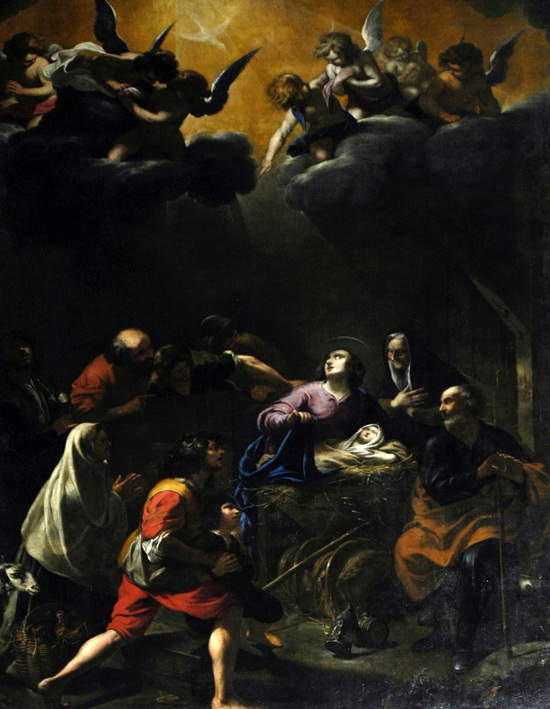 |
| Luciano Borzone, Nativity (1645; Genoa, Santissima Annunziata del Vastato) |
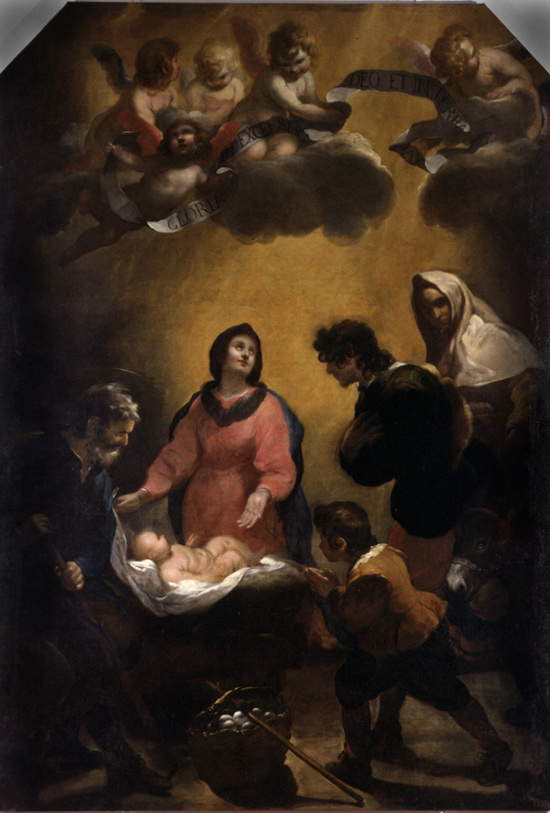 |
| Luciano Borzone, Adoration of the Shepherds (ca. 1635-1640; Savona, Pinacoteca Civica) |
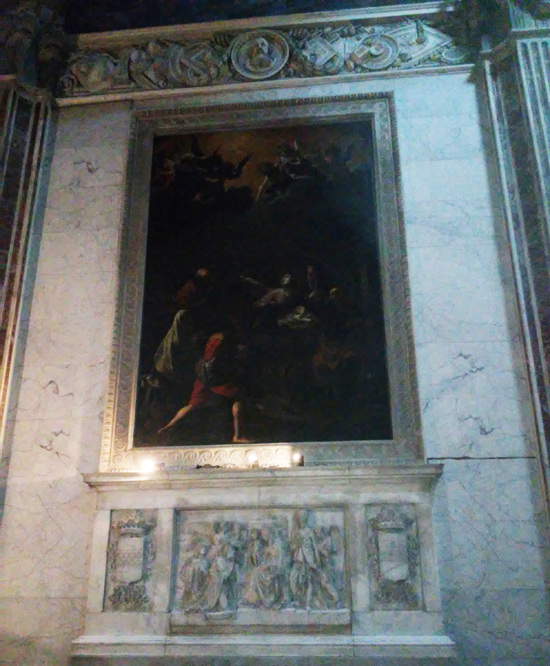 |
| Luciano Borzone’s nativity scene in the church of Santissima Annunziata del Vastato |
The lower area of the painting, on the other hand, is marked by a compositional freedom worthy of a great artist such as Luciano Borzone was: the characters, who repeat connotations and expressions that the painter had already experimented with in his previous paintings, are arranged almost following a circular movement that highlights the dynamism typical of Borzone’s art and is similar to the circle of the protagonists of theAdoration performed earlier. There is also no shortage of excerpts from everyday life: if in the painting now in Savona the artist placed a basket full of eggs in the foreground, in his latest work Luciano Borzone inserts lanterns resting on the ground, a basket with chickens, a sheep leaning out to the left, and it should also be noted how carefully and how naturally the artist paints the reflections of light on the strands of straw that make the manger that welcomes the baby Jesus less uncomfortable. These are all features that make the painting one of Luciano Borzone’s most interesting works: it is just a pity that over time the colors have undergone some alteration and today the panel appears to us darker than it was at the time the artist painted it.
From the church of Santissima Annunziata del Vastato we cross the entire historic center to go to what is perhaps the most beautiful and evocative part of old Genoa (or at least, it is in our opinion), the hill of Castello: it is here that the church of Santa Maria di Castello, with its small museum annex, opens up, always surprising those who walk along these caruggi. A jewel that we will have a chance to talk about in more detail another time: for today it is enough for us to know that another beautiful work by Luciano Borzone, the Preaching of St. Vincent Ferrer as a Child (as well as a couple of other canvases attributed to him although with several doubts), is kept in here. The Sermon is a painting also mentioned by Soprani, who among the works “worthy of note” points out “the panel that is seen in Santa Maria di Castello, in which he represented St. Vincent Ferrer when in boyhood he is preaching in the presence of his master, and fellow disciples.”
Saint Vincent Ferrer (also known as “Vincent Ferrer,” but the real name is Vicent Ferrer) was a Valencian preacher who lived in the late fourteenth and early fifteenth centuries, and was canonized by Callistus III in 1458: of noble origins, a tireless traveler belonging to the Dominican order and also a passionate teacher of philosophy, Vincent Ferrer felt his vocation from an early age. Such precocity is alluded to by the unusual subject of Luciano Borzone’s painting: although paintings depicting sermons and miracles by Vincent Ferrer abound, it should be pointed out that the saint is almost always portrayed as an adult, wearing the typical clothes of the Dominicans. Here, on the other hand, the protagonist of this composition, with Caravaggesque overtones, is a child who is strongly self-confident, and directly inspired by the divinity: in fact, he stands above a table with a solemn pose, and the sky, which floods him with golden light, rips open causing the Holy Spirit to descend on him precisely perpendicular to his figure. Here again, Luciano Borzone experiments with a wide variety of poses for the characters, who are all children, with the exception of the master of Vincent Ferrer, depicted as an old man with a long beard, on the left of the composition. So we have those who pray absorbed, we have two children who remain indifferent to the words of their companion, we have one, perhaps the most natural of all, who leans with an almost listless air on the same table on which the future saint has climbed.
And again, this was a prestigious commission: the patronage of the chapel of San Vincenzo Ferrer, for which the painting was intended, had been obtained in the early seventeenth century by the Brignole-Sale family, among the most prominent in the city. Moreover, like the painting of the Santissima Annunziata, the painting of Santa Maria di Castello is in less than optimal condition of preservation. But Luciano Borzone’s genius can still be seen.... !
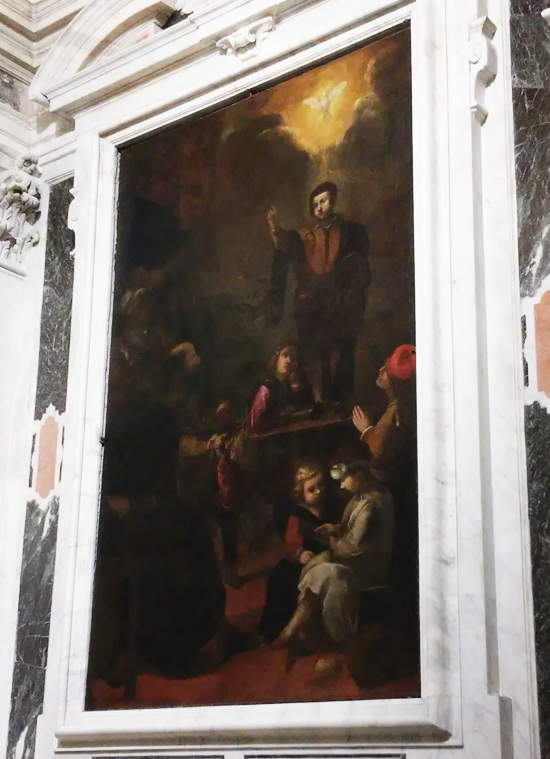 |
| Luciano Borzone, Preaching of St. Vincent Ferrer as a Child (ca. 1635; Genoa, Santa Maria di Castello) |
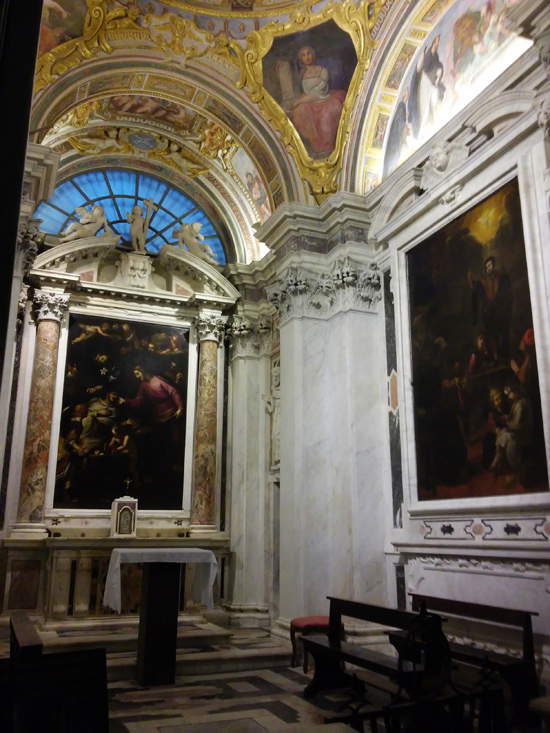 |
| The chapel of Saint Vincent Ferrer in the church of Santa Maria di Castello in Genoa. |
As mentioned in the opening, there are many works by the Genoese artist preserved in churches in and around Genoa (as well as in various museums in the area). On the occasion of the exhibition at Palazzo Nicolosio Lomellino, a brochure was created(which we link here) with a special section “Beyond the exhibition. Paintings by Luciano Borzone in Genoa and Liguria,” which contains a wide selection, divided by city and place of conservation, of the best works of the seventeenth-century painter found in the region. And of course the invitation is, again, to go and visit the essential monographic exhibition on Luciano Borzone!
Reference bibliography
Warning: the translation into English of the original Italian article was created using automatic tools. We undertake to review all articles, but we do not guarantee the total absence of inaccuracies in the translation due to the program. You can find the original by clicking on the ITA button. If you find any mistake,please contact us.